| |
Glossary of Coral Reef Terminology - G
G1 - phase in the cell cycle between the completion of cell division and the initiation of DNA synthesis |
G2 - phase in the cell cycle between the completion of DNA synthesis and the next cell division |
Ga - symbol for one billion (109) years. The a stands for the Latin annus, year |
Gaia theory - a model in which the organisms on the Earth have radically altered its composition. A stronger position is that the Earth's biosphere effectively acts as if it is a self-organizing system, which works in such a way as to keep its systems in some kind of equilibrium that is conducive to life |
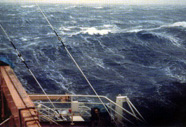
A gale at sea (Photo: NOAA)
|
gale - a storm with wind speeds between 34 to 40 knots |
galeiform - helmet-shaped |
gall - an abnormal outgrowth caused by infection or irritation by certain fungi or bacteria |
game species - species of animals that are hunted or fished, for purposes of sport, recreation, and food capture |
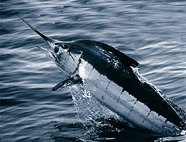
The blue marlin, Makaira nigricans, is a prized gamefish. (Photo: NOAA)
|
gamefish - a species of fish considered to possess sporting qualities on fishing tackle |
gamete - a sex cell, e.g., a spermatozoan or egg cell, produced by sexually reproducing orgnaisms |
gamete bundle - in coral sexual reproduction, the polyps of many species release bundles of eggs and sperm cells, called gamete bundles, that float to the sea surface. The layers surrounding the egg and sperm bundles soon rupture, releasing the gametes at the surface, where fertilization occurs |
gametocyte - a reproductive cell capable of dividing by meiosis to produce gametes, e.g., a spermatocyte or oocyte |
gametogenesis - the development and maturation of gametes (sex cells) through meiosis. The process is termed 'spermatogenesis' in the development of sperm cells and 'oogenesis' in the development of egg cells |
gametophyte - a life cycle stage in certain algae that produces male and female reproductive organs |
gamma ray - an electromagnetic wave or photon emitted from the nucleus |
gamodeme - a deme forming a more or less isolated local intrabreeding community |
ganglion - a cluster of nerve tissue primarily composed of cell bodies of neurons, usually located outside of the central nervous system; a knotlike swelling of an invertebrate's nerve cord that contains a concentration of coordinating nerve cells |
gap analysis - a Geographic Information System (GIS) methodology to identify the distribution of biodiversity over large spatial areas. It was developed in 1988 by the U.S. Geological Survey in an effort to ensure that regions rich in species diversity are conserved with the hope that this will eliminate the need to list species as threatened or endangered in the future. The gap analysis approach uses maps of vegetation and predicted animal distributions to locate centers of species richness outside areas currently managed for biodiversity protection. These are considered the "gaps" of gap analysis. Thus far, its use primarily has been in the terrestrial sphere |
gap dynamics - the formation and replacement of patches or gaps in a seascape or landscape, as in the destruction of corals and growth of new corals in that opening |
gap formation - the creation of a habitat patch of different characteristics within a larger patch; the generation of patches in a seascape or landscape, such as the generation of openings in a coral reef as a result of storm damage or coral death |
gap junction - a junction between certain animal cell types that allows different molecules and ions (small intracellular signaling molecules) to pass freely between cells. The junction connects the cytoplasm of the cells. One gap junction is composed of two hemichannels which connect across the intercellular space, one from each cell. They are analogous to plasmodesmata that join plant cells; also called "nexus" |
gap phases - the phases of the cell cycle known as G1 and G2, during which relatively less obvious cellular activity is visible |
gape - the measurement of the widest opening of a mouth; to open the mouth wide; yawn; an opening |
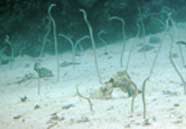
Red Sea garden eels (Gorgasia sillneri) in Hurghada, Red Sea. Garden eels live in colonies in sandy bottoms adjacent to coral reefs. They live individually in burrows from which they protrude to feed on plankton. (Photo: Thomas Jundt)
|
garden eel - a family of eels (Heterocongridae) that occur in colonies in the sandy bottoms adjacent to coral reefs, where they live individually in burrows from which they protrude to feed on plankton. From a distance these eels resemble a field of seagrass. They are very shy and disappear into their burrows at the approach of a potential predator |
gas - a major state of matter consisting of freely moving atoms and molecules with no definite shape or volume, like air |
gas chromatograph/mass spectrometer (GC/MS) - an instrument that identifies the molecular composition and concentrations of various chemicals in water and soil samples |
gas chromatography - a method of separating chemical components of a mixture, which involves the passage of a gaseous sample through a column having a fixed adsorbent phase |
gas hydrate - see "methane hydrate" |
gas laws - laws that predict how gases will behave with changes in temperature, pressure, and volume |
gastric - pertaining to the stomach |
gastric filaments - in scyphozoan medusae, a fringe of short, threadlike filaments whose secretory cells secrete digestive enzymes. They are located on the floor of each gastric pouch |
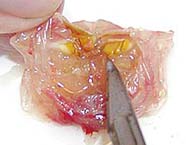
Gastric mill and teeth within the stomach of a grooved tanner crab (Chionoecetes tanneri). (Photo: NOAA)
|
gastric mill - the grinding apparatus in the cardiac stomach of crustaceans. It is formed by three chitinous teeth that project into the stomach; the thick-walled muscular pouch below the crop in many birds and reptiles, used for grinding food |
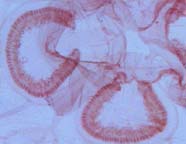
Gastric pouch region of the jellyfish, Aurelia. The horseshoe-shaped structure is a gonad. (Photo: John Houseman, BIODIDAC)
|
gastric pouch - in scyphozoans (jellyfish), one of four sacs is which food in digested. Each pouch contains a conspicuous horseshoe-shaped gonad on its floor |
gastrodermis - the epithelial lining of the gastrovascular (digestive) cavity of cnidarians and ctenophores (comb jellies) |
gastrolith - A deposit of calcium salts made in the stomach of many crustaceans during the period between molts. It may be used to store calcium needed in the new exoskeleton |
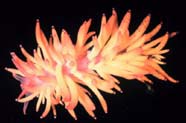
A sea slug of the Class Gastropoda, Phylum Mollusca.
|
Gastropoda - a class of the phylum Mollusca that includes snails, sea slugs, nudibranchs, limpets, and cone shells. There are approximately 30,000 living species described. Many species are inhabitants of coral reefs and nearby seagrass beds |
gastropore - a pore in the hard skeleton of a hydrozoan colony which houses a gastrozooid (feeding polyp) |
gastrostyle - a small central support column of the feeding polyps (gastrozooids) of a hydrocoral |
gastrovascular canal - a canal system, lined with gastrodermis, that connects the gastrovascular cavities of colonial coral polyps |
gastrovascular cavity - the internal digestive cavity of cnidarians and ctenophores that is lined with the gastrodermis |
gastrozooid - a polyp in hydrozoans and other colonial cnidarians which is specialized for feeding |
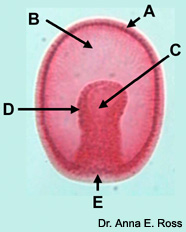
An echinoderm gastrula. It was formed by the invagination of blastomeres at the vegetal pole area of the blastula to produce the archenteron, which will become the digestive system.The opening into the archenteron is the blastopore, which will become the anus of the adult. The cavity of the archenteron is the gastrocoel. The roof of the archenteron, which forms the mesoderm, will expand and pinch off mesodermal vessicles with an internal cavity that will become the coelom (see: mesoderm). A - ectoderm; B - blastocoel; C - archenteron; D - endoderm; E - blastopore. (Photo: Dr. Anna E. Ross, Christian Brothers University, TN)
|
gastrula - the embryonic stage of an animal that has cells differentiated into germ layers. Sequentially, It follows the blastula stage |

An early gastrula. The cells at the vegetal hemisphere have begun to invaginate into the blastocoel, forming the archenteron. (Photo: Dr. Anna E. Ross, Christian Brothers University, TN)
|
gastrulation - during embryonic development of most animals, a complex and coordinated series of cellular movements occurs at the end of cleavage. The details of these movements vary among species, but usually result in the formation of of an embryonic stage termed the gastrula. The gastrula has two primary germ layers, the ectoderm and endoderm in diploblastic animals, and three primary germ layers with the development of the mesoderm in triploblastic animals |
Gause's principle - the principle that "no two species can coexist indefinitely on the same limiting resource." Also called Gause's Law, or the 'competitive exclusion principle' |
gaussian distribution - a bell-shaped distribution of results from a normal sample population; a normal distribution with a mean of 0 and a variance of 1 |
gazetteer - a dictionary or index of geographical names with locations |
gb (gigabase pairs) - one billion (109) pairs of nucleotide bases in DNA |
GBIF (Global Biodiversity Information Facility) - an international non-profit organization that provides free and universal access to data regarding the world's biodiversity. A wide range of countries and organizations participate in GBIF and have made their data available through the GBIF web site (http://www.gbif.org) |
GCRMN (Global Coral Reef Monitoring Network) - a global network whose aim is to improve management and sustainable conservation of coral reefs for people by assessing the status and trends in the reefs and how people use and value the resources. It does this by providing many people with the capacity to assess their own resources, within a global network, and to spread the word on reef status and trends |
gel - a jelly-like substance formed by the coagulation of a colloidal liquid; a cytoplasmic phase |
gel electrophoresis - a process for separating molecules by forcing them to migrate through a gel under the influence of an electric field |
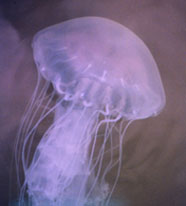
the body of a jellyfish has a gelatinous consistency. (Photo: Mary Hollinger/NOAA)
|
gelatinous - having the the consistence of jelly |
geminate species - a little differentiated species evolved from a close common ancestor; a "twin" species. For example, pairs on either side of the Isthmus of Panama who are each other's closest relative and were probably one species before the sea level dropped |

A sponge gemmule. Calcareous spicules projecting from the covering of the gemmule provide additional protection. (Photo credit: Rick Gillis, Ph.D., Biology Dept., University of Wisconsin-La Crosse)
|
gemmule - an asexual, spore-like reproductive unit in sponges, capable of overwintering and developing into an adult sponge the following summer |
gen. et sp. nov. - in taxonomy, the abbreviation for genus et species nova, meaning new genus and species |
gene - the functional and physical unit of heredity passed from parent to offspring. Genes are pieces of DNA, and most genes contain the information for making a specific protein |
gene amplification - a selective increase in the number of copies of a gene which codes for a specific protein without a proportional increase in other genes |
gene array - a regular pattern of DNA fragments, or oligonucleotides, spotted onto a solid support and used as a diagnostic tool to measure many individual gene expression levels simultaneously |
gene duplication - gene duplication occurs when an error in DNA replication leads to the duplication of a region of DNA containing a functional gene. The duplicated gene is free to mutate and may take on new functions. The two genes that exists after a gene duplication event are termed paralogous genes, or paralogs. Gene duplication may have a major role in evolution |
gene expression - the conversion of information from gene to protein via transcription and translation |
gene flow - the movement of genes through or between populations as the result of out-crossing and natural selection |
gene frequency - the relative occurrence of a gene in a given population, usually expressed as a percentage |
gene index - a listing of the number, type, label and sequence of all the genes identified within the genome of a given organism |
gene locus - the specific place on a chromosome where a gene is located |
gene mapping - determination of the relative locations of genes on a chromosome |
gene pool - the sum total of genes, with all their variations, possessed by a particular species at a particular time |
gene product - the product, either RNA or protein, that results from expression of a gene. The amount of gene product reflects the activity of the gene |
gene silencing - the interruption or suppression of the expression of a gene at the levels of transcription or translation |
gene splicing - a cell process by which a gene is cut into different parts, exons and introns. The exons are the coding region and are put back together to make the gene that is transcribed and translated into a protein |
gene therapy - an approach to preventing and/or treating disease by replacing, removing or introducing genes or otherwise manipulating genetic material. In some cases, the material can be injected with a genetic vaccination. In other cases the material is introduced through harmless bioengineered viruses that carry the therapeutic gene to the cell. Globules known as liposomes can also be used to carry therapeutic genes to specific cells |
gene tree - a phylogeny of a gene, which may or may not accurately reflect the phylogeny of the organisms possessing that gene |
gene-based medicine - instead of solely replacing defective genes, gene-based medicine is the application of nucleic acids (DNA, RNA) containing genetic information as therapeutic reagents in general. Nucleic acids are used to add a therapeutically beneficial function to cells, delete pathological functions from cells, or utilize cells for the production of therapeutic proteins. This can be either a transient or a permanent effect |
genecology - the study of the genetic basis of ecological differentiation; the study of the genetic composition of populations in relation to their habitats |
generalist - an organism which can survive under a wide variety of environmental conditions, and does not specialize to exist under any particular set of circumstances |
generation - offspring from the same parental group going through their life cycle together |
genetic assimilation - the disappearance of a species as its genes are diluted through crossbreeding with a closely related species |
genetic code - the chemical code by which genetic information in DNA is translated into biological function. A set of three nucleotides (codons), the building blocks of DNA, signifies one amino acid. Amino acids are the the building blocks of proteins |
genetic disease - a disease that has its origin in changes to the genetic material. Genetic diseases usually refer to diseases that are inherited in a Mendelian fashion, although non-inherited forms may also result from genic (DNA) mutation |
genetic distance - a measure of the genetic similarity between any pair of populations. Such distance may be based on phenotypic traits, allele frequencies or DNA sequences; any of several measures of the degree of genetic difference between populations, based on differences in allele frequencies. Genetic distances are used for understanding effects of genetic drift and gene flow |
genetic distancing - a measure of the genetic similarity between any pair of populations. Such distance may be based on phenotypic traits, allele frequencies or DNA sequences. For example, genetic distance between two populations having the same allele frequencies at a particular locus, and based solely on that locus, is zero. The distance for one locus is maximum when the two populations are fixed for different alleles. When allele frequencies are estimated for many loci, the genetic distance is obtained by averaging over these loci |
genetic diversity - the variety of different types of genes or alleles in a species or population |
genetic drift - random changes in the frequency of alleles in a population. In small populations, it can lead to the elimination of a particular allele by chance alone. It is thought to be one cause of speciation when a group of organisms is separated from its parent population |
genetic engineering - the technique of selectively removing, modifying, or adding genes to a DNA molecule by use of recombinant DNA or other specific molecular gene transfer or exchange techniques. These techniques produce endogenous proteins with properties different from those of the normal, or to produce entirely different proteins altogether. Organisms modified by genetic engineering are sometimes referred to as transgenic, bioengineered, or genetically modified |
genetic erosion - a process whereby an already limited gene pool of an endangered, sexually reproducing species diminishes even more when individuals from the surviving population die off without getting a chance to breed with others in their endangered low population. Genetic erosion occurs because each individual organism has many unique alleles which get lost when it dies without getting a chance to reproduce; the loss of genetic diversity within the same species over time, due to human intervention or environmental changes |
genetic expression - the process by which genetic information contained in DNA is converted into proteins within a cell. The gene is said to express or code for a particular protein |
genetic map position - the location of a gene on a genetic map, deduced from recombination frequencies |
genetic marker - a DNA sequence used to "mark" or track a particular location (locus) on a particular chromosome |
genetic modification - human-designed changes in an organism, whether done through traditional breeding or genetic engineering. The terms "genetically modified" and "genetically engineered" are sometimes used interchangeably |
genetic mutation - a permanent structural alteration in DNA. In most cases, DNA changes either have no effect or cause harm, but occasionally a mutation can improve an organism's chance of surviving and passing the beneficial change on to its descendants |
genetic pollution - the uncontrolled and undesirable gene flow into the genomes of organisms in which such genes are not present in the wild state. The term is usually associated with the gene flow from a genetically engineered or genetically modifed organism to a non-genetically engineered or modified organism. In some instances it has also been used to describe gene flow from an invasive or domesticated species to a wild population; the accidental tranfer of genetic material from a genetically engineered organism to one that is not genetically engineered |
genetic stability - a measure of the resistance to change, with time, of the sequence of genes within a DNA molecule or of the nucleotide sequence within a gene |
genetically modified organism - an organism that has been modified by the application of recombinant DNA technology |
genital bursa - an invagination at the base of an arm of a brittle star. Each bursa is a pouch lined with ciliated epidermis and is the primary respiratory surface for the organs of the perivisceral coelom. The epidermal cilia generate a ventilating current. The bursae have the gonads on the coelomic side of their wall |
genome - all the DNA contained in an organism or a cell, which includes both the chromosomes within the nucleus and the DNA in mitochondria |
genome size - the size of a genome (all the genetic material in the chromosomes of a particular organism) is generally given as its total number of base pairs |
genomic library - a collection of clones made from a set of randomly generated overlapping DNA fragments that represent the entire genome of an organism |
genomics - the comprehensive analysis of all the genes of an organism; molecular characterization of all the genes and gene products of a species, including the study of gene sequences, gene mapping, and gene function; genomics usually involves high speed sequencing of the DNA and computer searches for sequences that code for genes. Genomics allow researchers to identify specific genes responsible for specific proteins with specific functions in an organism |
genotype - the genetic constitution of an individual or group. In taxonomy, the genotype is the type species of a genus |
genus - a taxonomic group containing one or more species |
geo-referenced data - refers to data with geographic location information included, such as latitude and longitude |
geochemistry - the study of the chemical elements, their isotopes, and related processes with respect to the abundance and distribution of materials within the Earth's waters, crust, and atmosphere |
geoecotype - a regional ecotype (a population adapted to a restricted habitat as a result of natural selection within a local environment) |
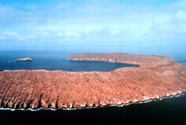
Populations may be isolated on adjacent islands, leading to speciation (Photo: Lt. Debora Barr, NOAA Corps)
|
geographical isolation - a form of reproductive isolation in which members of a population become separated from another population by geographical barriers that prevent the interchange of genes between the separated populations |
geographical speciation - speciation occurring during a period of geographical isolation |
GeoHab - a joint SCOR-IOC Program of international cooperative research on harmful algal blooms (HABs) in marine and brackish waters |
geoid - the hypothetical surface of the Earth that coincides everywhere with the mean sea level |
geologic time scale - a relative time scale based upon fossil content. Geological time is divided into eons, eras, periods, and epochs |
geomorphology - the study of landforms and the processes which shape them |

Artist+s rendition of GOES I/M, geostationary satellites whose mission includes data collection and broadcasting, and environmental sensing. (Image: NASA/Goddard Space Flight Center)
|
geostationary satellite - satellite whose orbit around the equator equals that of the Earth's rotation, making it possible for them to view the same disc of Earth's surface below continuously |
geostrophic current - a flow that sustains a balance between Coriolis deflection and a pressure gradient |
geotextile - a product used as a soil reinforcement agent and as a filter medium. It is made of synthetic fibers manufactured in a woven or loose nonwoven manner to form a blanket-like product, e.g., a silt curtain |
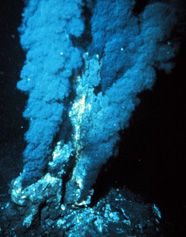
A "Black smoker" at a mid-ocean ridge geothermal vent (Photo: Dr Peter Rona)
|
geothermal vent - a submerged feature consisting of a vent of hot, mineral-rich waters on the ocean floor; geothermal vents are generally located on or near spreading oceanic ridges or on the continental margins of subduction trenches |
Geotiff - a file format that embeds image registration information directly into a raster file; an industry-neutral raster file format widely used and recognized by all of the major GIS software vendors. ESRI began support for Geotiff at version 7.0 of ARC/INFO and version 3.0 of ArcView. Geotiff represents an effort by over 160 different remote sensing, GIS, cartographic, and surveying related companies and organizations to establish a TIFF-based interchange format for georeferenced raster imagery |
geotropism - a turning or growth movement by a plant in response to gravity. Plant parts that grow downward, such as the roots, would be positive geotropism. A negative geotropism would be the stems growing upward |
germ cell - a gamete; a haploid sperm or egg cell or their precursors |
germ layers - distinct layers of cells, produced during the early embryonic developmental process of gastrulation, which gives rise to all cells, tissues, organs, and organ systems of the organism's body. The three types of germ layers are the ectoderm, endoderm, and mesoderm. Diploblastic organisms (e.g. cnidarians) have two layers, ectoderm and endoderm; triploblastic organisms (all higher animal groups) have mesoderm between these two layers |
germinal epithelium - the tissues of the primary reproductive organs that produce eggs and sperm cells |
gestation period - the period of development of the young in viviparous animals, from the time of zygote formation (fertilization) until birth |
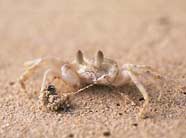
The ghost crab, Ocypode pallidula,gets its name comes from its ability to blend in with sand, then alternately “appear” and “disappear" while making rapid sharp directional changes (Photo: Keoki and Yuko Stender)
|
ghost crab - any of several light-colored burrowing crabs of the genus Ocypoda frequenting the tide line along sandy shores from the northeast United States to Brazil. Ghost Crabs have a relatively thin, light exoskeleton and two large black eyes that stand up like periscopes. They are called ghosts because of their ability to instantly disappear from sight, moving at speeds at speeds up to 10 miles per hour, while making sharp directional change and disappearing into their burrows |
ghost net - a lost or abandoned fishing net that drifts through the oceans posing a danger to fishes and other marine life |
gibbosity - swelling or protuberance; a convex hump; something that bulges out or is protuberant or projects from a form |
giesma - in a histological preparation, a stain which contains both basic and acidic dyes |
GIF (Graphics Interchange Format) - a bit-mapped digital image graphics file format suitable for efficiently importing image data into computer files or for transmitting or displaying the formatted image on a computer monitor or printing it out. GIF supports color and various resolutions. It also includes data compression, making it especially effective for scanned photos |
gigabyte (gb) - a measurement of storage space equal to a thousand megabytes |
Gilbert Islands - a group of 11 atolls and 5 islands in an approximate north-to-south line, located in the western regions of the central Pacific. They are situated across the equator, which serves as dividing line between the northern Gilbert Islands and the southern Gilbert Islands. They are the main part of the Republic of Kiribati |
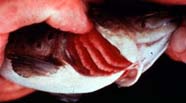
The gill cover (operculum) of this fish is lifted to expose the gills, which are the respiratory organs of fishes and many other aquatic animals.
|
gill - a highly vascularized respiratory organ with a large surface area in aquatic animals. Gills are in direct contact with the surrounding water for gas exchange |
gill arch - one of several curved bony or cartilaginous structures located on either side of the pharynx that support the gills of fishes and amphibians. Each gill arch is made up of an upper and a lower limb that are joined posteriorly. The gill filaments and gill rakers are attached to the gill arches |
gill chamber - in fishes, the cavity containing the gills on each side of the rear of the head, enclosed by the operculum and the branchiostegal membrane |
gill filament - a fingerlike projection from a gill arch through which respiratory gases enter and leave the blood |
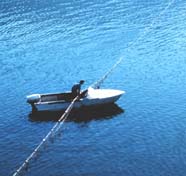
A fisherman setting out a gill net. (Photo: NOAA)
|
gill net - a net primarily designed to catch fish by entanglement in a mesh that consists of a single sheet of webbing which hangs between cork line and lead line, and which is fished from the surface of the water |
gill pouch - an anatomical structure of bivalves used to protect developing embryos; located in the gills |
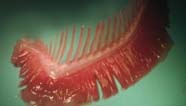
Gill arch of an almaco jack (Seriola rivoliana) showing the gill rakers and gill filaments. (Photo: NOAA)
|
gill raker - one of a series of knob- or comb-like projections on the front edge of the gill arch. Gill rakers aid in the fish's feeding. Their shape and number are a good indication of the diet of the fish. Fishes which eat large prey, such as other fishes, have short, widely spaced gill rakers that prevent the prey item from escaping between the gills. Fishes which eat smaller prey have longer, thinner and more numerous gill rakers. Species which feed on plankton have the longest, thinnest and most numerous gill rakers. Gill rakers also protect and clean the gill fillaments. Counts of gill rakers are used as taxonomic characters |
gill tuft - a fluffy cluster of gill filaments |
GIS (Geographic Information System) - a system that allows automatic location of information suitable for mapping. Usually involves a software system that takes geographic position data and other data (e.g., type of bottom sediment) in order to create a map. Data on processes (e.g., current speed) can be incorporated to make a geographic model of flow |
give-up reef - a coral reef which is not growing fast enough to keep up with sea level rise |
glabrous - refers to a smooth surface without hairs or setae |
gland - a group of cells or a single cell in animals or plants that is specialized to secrete a specific substance |
gland cell - an epithelial cell that secretes digestive enzymes into the gastrovascular cavity of a cnidarian; also called "granular gland cell" or "zymogen cell" |

Glass sponges recovered from 1400 feet. Glass sponges are typically very fragile and rarely hold their shape when transported to the surface (Photo: Bruce Moravchik/NOAA)
|
glass sponge - a hexactinellid sponge, found at deeper depths, with a skeleton made of four and/or six pointed silaceous spicules |
global change - a transformation which occurs on a worldwide scale (for example, an increase in CO2 in the atmosphere) or exhibits sufficient cumulative effects to have worldwide impact (for example, local species extinction resulting in global loss of biodiversity) |
Global Environment Facility (GEF) - an independent financial organization that provides grants to developing countries for projects that benefit the global environment and promote sustainable livelihoods in local communities. GEF funds are contributed by donor countries. GEF grants support projects related to biodiversity, climate change, international waters, land degradation, the ozone layer, and persistent organic pollutants |
Global Taxonomy Initiative (GTI) - initiative established by the Conference of the Parties to the Convention on Biological Diversity (CBD) to address the lack of taxonomic information and expertise around the world |
global temperature - an area-weighted mean of temperatures recorded at ground and sea surface -based observation sites around the globe, supplemented by satellite or model-based records in remote regions; usually referring to sea surface temperature |
Global Temperature-Salinity Profile Program (GTSPP) - a cooperative international program designed to develop and maintain a global ocean Temperature-Salinity resource with data that are as up-to-date and of the highest quality as possible. The primary goal of the GTSPP is to make these data quickly and easily accessible to users. Both real-time data transmitted over the Global Telecommunications System (GTS), and delayed-mode data received by the U.S. National Oceanographic Data Center (NODC) are acquired and incorporated into a continuously managed database. Countries contributing to the project are Australia, Canada, France, Germany, Japan, Russia, and the United States. Canada's Marine Environmental Data Service (MEDS) leads the project, and has the operational responsibility to gather and process the real-time data |
global warming - the gradual increase in global temperatures caused by the emission of gases that trap the sun's heat in the Earth's atmosphere (greenhouse effect). Gases that contribute to global warming include carbon dioxide, methane, nitrous oxides, chlorofluorocarbons (CFCs), and halocarbons (the replacements for CFCs). The carbon dioxide emissions are primarily caused by the use of fossil fuels for energy |
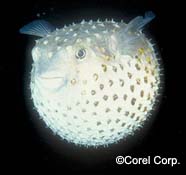
The porcupine fish, when threatened, swallows water and takes on a globular shape. (Photo: Copyright Corel Corporation)
|
globular - globe-shaped; having the form of a sphere, or nearly so |
glossary - an alphabetical list of technical terms, with brief definitions for those terms, in some specialized field of knowledge |
glucose - a monosaccharide,C6H12O6, that is the end product of carbohydrate metabolism and is the chief source of energy for living organisms |
glutamate - an amino acid neurotransmitter that acts to excite neurons. Glutamate is thought to play an integral role in neural pathways associated with learning and memory |
glutamate receptor - a protein molecule that helps gate the flow of ions across a neuron's cell membrane |
glycan - a polysaccharide consisting of monosaccharides joined by glycosidic linkages |
glycobiology - a field of science that combines carbohydrate (sugar) biochemistry and molecular biology. Glycobiology includes the study of the structure, chemistry, biosynthesis, and biological functions of glycans and their derivatives; also called glycomics |
glycomics - see glycobiology |
glycosidic bond - a type of covalent bond that joins two monosaccharides (simple sugars) via an atom of oxygen |
glycosidic linkage - a bond formed between a hemiacetal group of a sugar molecule (such as glucose) and an alcohol functional group to form an acetal |
gnathic - pertaining to the jaw |
Gnathostomata - the group of vertebrates that possess jaws; includes fishes, amphibians, reptiles, birds, and mammals |

The yellow goatfish, Mulloidichthys martinicus, uses barbels to dig in sand or coral rubble for food, usually small invertebrates. (Photo: NOAA)
|
goatfish - any species of bony fishes in the family Mullidae. Goatfishes, also called surmullets, are elongate, moderately sized fishes which are characterized by a pair of long, tactile barbels under the chin. Some species are brilliantly colored and some are noted |
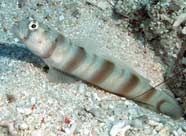
The antitropical shrimpgoby, Amblyeleotris ogasawarensis. This species of goby grows to 11cm in length. It lives in a burrow with a snapping shrimp(Photo: John E. Randall, Ph.D.)
|
goby - any species of bony spiny-rayed fishes in the family gobiidae. Gobies are small fishes with large heads and elongated tapering bodies. They comprise the largest family of marine fishes, with over 2000 species. Gobies range in size from the mudskipper (about 15-30 cm) to the tiny pygmy goby, Eviota sigillata, a 1-2 cm long coral reef-dwelling goby which has the shortest lifespan for any known vertebrate |
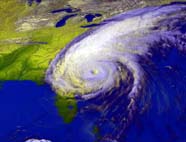
Image developed by NASA from GOES data-Hurricane Floyd at the U.S. coast�on September 15, 1999 (Hal Pierce, NASA Goddard Space Flight Center)
|
GOES (Geostationary Operational Environmental Satellite) - a class of satellite operated by NOAA, positioned in a nearly stationary orbit over the equator at an altitude of about 22,500 miles. GOES-8 is currently the operational "east" spacecraft at 75 degrees West longitude, while GOES-10 is the "west" spacecraft located at 135 degrees West. GOES-11 is in standby at 110 degrees West |
gonads - the primary sex organs of an animal. In males they are the testes, and in females, the ovaries |
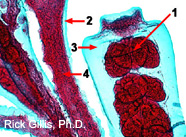
A gonangium of the hydrozoan Obelia. 1= medusa bud; 2= perisarc; 3=gonotheca; 4= coenosarc. (Photo: Rick Gillis, Ph.D., Biology Dept., University of Wisconsin-La Crosse)
|
gonangium - a reproductive polyp of a colonial hydrozoan. It consists of a stalk containing medusa buds surrounded by a thin membrane, the gonotheca |
gonochoric - having separate sexes. Individuals within the species contain only one or the other of male and female reproductive systems |
gonoduct - any duct that generally transfers eggs or sperm cells |
gonophore - a sexual zooid produced as a medusa bud upon a hydroid, sometimes becoming a free hydromedusa and sometimes remaining attached |
gonopodium - a term given to the anal fin (or the anterior portion of it) of a male fish when it is modified to function as a copulatory organ, e.g., in guppies |
gonopore - an opening between the reproductive system and the outside environment; the genital pore of many invertebrates |
gonosome - a collective term for all reproductive structures of a colonial hydrozoan |
gonotheca - a thin membrane covering the body of a gonangium, the reproductive polyp of a colonial hydrozoan |
gonozooid - a reproductive polyp of a colonial hydrozoan |
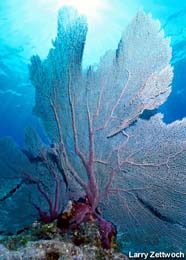
A sea fan, Gorgonia ventalina, in the Florida Keys.
|
gorgonian - an anthozoan of the subclass Octocorallia, commonly called sea fans and sea whips |
gorgonin - a fibrous protein in the mesoglea which provides skeletal support for sea fans and other members of the Order Gorgonacea |
government document - a publication produced by a government agency |
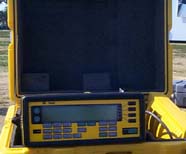
Portable GPS unit utilized in surveying.
|
GPS (Global Positioning System) - a network of satellites and receiving devices used to compute accurate geographical positions on the Earth. A GPS is used in navigation, and its precision supports cadastral surveying |
gradient analysis - an intuitive method to portray variation along a single or multiple environmental gradients. The plots display species or community abundance in response to a known environmental gradient, i.e., the analysis of species composition along a gradient of environmental conditions |
gradualism - a model of evolution that assumes slow, steady rates of change, as contrasted with punctuated equilibrium, an evolutionary model in which change occurs in relatively rapid bursts |
gram atom (g-at) - the quantity of an element whose weight in grams is numerically equal to the atomic weight of the element; represents the mass in grams of Avogadro's number of atoms of the element |
Gram's stain - a method for differential staining of bacteria; Gram-positive cells stain purple-black and Gram-negative cells stain pink; useful in bacterial taxonomy and identification |
grassroots - people or society at a local level, rather than at the center of major political activity. A grassroots movement is one driven by the constituents of a community |
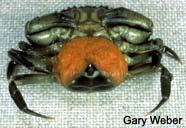
Gravid green crab with egg mass on the abdomen. (Photo: Gary Weber)
|
gravid - pregnant; heavy with young; full of ripe eggs or distended by such fullness |
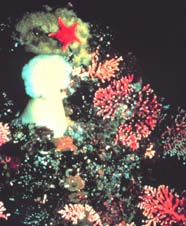
A reef scene showing biodiversity at Gray's Reef. (Photo: NOAA)
|
Gray's Reef National Marine Sanctuary - Gray's Reef comprises one of the largest nearshore sandstone reefs in the southeastern United States.It is located 32 kilometers (17.5 nautical miles) off Sapelo Island, Georgia. Designated in 1981, the Gray's Reef National Marine Sanctuary boundaries protect 17 square miles of open ocean. Sandstone outcroppings and ledges up to ten feet in height separate the sandy, flat-bottomed troughs in a reef that combines temperate and tropical flora and fauna. The rocky platform, some 60 to 70 feet below the surface, is covered by a carpet of attached organisms and is known locally as a "live bottom habitat." Gray's reef is not a coral reef. It is a consolidation of marine and terrestrial sediments (sand, shell, and mud) which was laid down as loose aggregate between 6 and 2 million years ago |
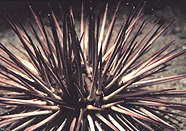
Sea urchins are important grazers on coral reefs. Their diet, however, is not totally restricted to plants and algae.
|
grazer - an animal which feeds on plants |
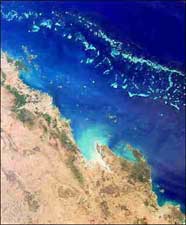
Satellite photograph of the Great Barrier Reef situated off the northerastern coast of Australia.
|
Great Barrier Reef - the largest complex barrier coral reef in the world, approximately 2,000 km (1,250 mi) long, in the Coral Sea, forming a natural breakwater for the northeastern coast of Australia. It is separated from the mainland by a shallow lagoon from 16–161 km (10 to 100 mi) wide. It is It is composed of more than 2,800 individual reefs and in some places it is more than 122 m (400 ft) thick. The Great Barrier Reef Marine Park, more than 340,000 km2 (130,000 mi2), encompasses most of the reefs and interreef areas as well as the neighboring lagoon and a large section of the continental shelf. It is the largest UNESCO World Heritage Area |
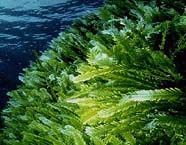
The green alga Caulerpa taxifolia with feather-like branches. The leaf is 5-65 cm in length. (Photo: NOAA)
|
green algae - green algae belong to the Division Chlorophycota. These algae contain photosynthetic pigments similar to those in higher plants (chlorophylls a and b, as well as secondary pigments: carotenes, lutein, and zeaxanthin) and have a green color. Green algae include unicellular forms, filamentous forms, and leaf-like thalluses. |
green fluorescent protein (GFP) - a protein produced by a jellyfish Aequorea victoria which fluoresces in the lower green portion of the visible spectrum when exposed to blue light. GFP has become an invaluable tool in contemporary cell and molecular biology research, because its intrinsic fluorescence can be visualized in living cells. GFP has become well established as a marker of gene expression and protein targeting in intact cells and organisms. Mutagenesis and engineering of GFP into chimeric proteins are opening new vistas in physiological indicators, biosensors, and photochemical memories |
green gland - in some crustaceans (shrimp, crabs, lobsters), an excretory gland with ducts opening near the base of the large antennae; also called "antennal gland" |
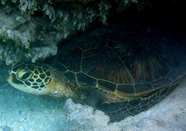
The range of the endangered green turtle, Chelonia mydus, extends throughout tropical and subtropical oceans worldwide. (Photo: Dr. Dwayne Meadows/N
|
green turtle - one of seven extant species of marine turtles. The green turtle, Chelonia mydas, is herbivorous and feeds on algae and seagrasses. It is in the family Cheloniidae |
greenhouse effect - the heating that occurs when gases such as carbon dioxide trap heat escaping from the Earth and radiate it back to the surface |
greenhouse gases - atmospheric gases, primarily carbon dioxide, methane, and nitrous oxide restricting some heat-energy from escaping directly back into space |
gregarious - living or moving in a group with others of its kind, as in a flock of birds or school of fish |
grid - a network of uniformly spaced parallel lines intersecting at right angles. When superimposed on a map, it usually carries the name of the projection used for the map. For example: Lambert grid, transverse Mercator grid, and universal transverse Mercator grid |
griseous - blue-grey color |
Grocott-Gomori's methenamine silver stain (GMS) - in histology, a stain preparation for fungi |

A groin is a relatively slender permeable or impermeable barrier structure aligned and constructed to trap littoral drift or retard erosion of the shore. This is a photograph of a timber pile groin
|
groin - a solid structure built at an angle from a shore prevent erosion from currents, tides and waves, or to trap sand |
gross photosynthetic rate - the total rate of CO2 fixation with no allowance for the CO2 simultaneously lost during respiration |
gross primary production - the total amount or weight of organic matter created by photosynthesis over a defined time period (total product of photosynthesis) |
ground truthing - measurements conducted on the ground or at sea to calibrate, compare or verify observations made from satellites or aircraft |
ground water - underground water that is generally found in the pore space of rocks or sediments and that can be collected with wells, tunnels, or drainage galleries, or that flows naturally to the earth's surface via seeps or springs. The term is not applied to water that is percolating or held in the top layers of the soil, but to that water in the zone of saturation below the water table |
groundfish - fishes, usually of commercial value, that live on or near the bottom; also called "bottom fish" |
grounding - a ship's striking a shoal or reef |
groundwater seep - subsurface water flowing into a coastal body of water |
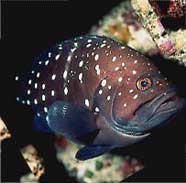
The Hawaiian grouper, Epinephelus quernus, is endemic to Hawaii. It attains at least 3 feet and 50 pounds (Photo: Keoki and Yuko Stender)
|
grouper - any species of bony fishes in the subfamily Epinephelinae of the sea bass family, Serranidae. Groupers have a typical seabass appearance with robust bodies, large mouths and sharp teeth. Some get to be enormous in size, many feet long and reaching weights |
growth band - a band formed yearly on coral by the secretion of CaCO3; one yearly growth band contains two smaller bands representing winter growth and summer growth |
growth factor - any of various chemicals, particularly polypeptides, that have a variety of important roles in the stimulation of new cell growth and cell maintenance. They bind to the cell surface on receptors. Specific growth factors can cause new cell proliferation |
growth rate - the increase in mass per unit of time |
growth - an increase in cell size or cell number, or both |
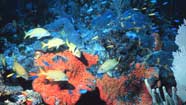
Blue striped grunts (Haemulon sciurus) in the Florida Keys National Marine Sanctuary (Photo: NOAA)
|
grunt - any species of bony spiny-rayed fishes in the family Haemulidae. Grunts are medium-sized tropical fishes that are capable of making a grunting sounds by the grinding of pharyngeal teeth.They inhabit coral reef or hard bottom areas. Many forage at night over nearby sand and grass flats |
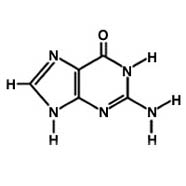
Diagram of the chemical structure of guanine, one of the four nitrogenous bases in DNA.
|
guanine - one of the four nitogenous bases in DNA and RNA that make up the letters ATGC, guanine is the "G". The others are adenine, cytosine, and thymine. Guanine always pairs with cytosine |

Bird droppings form the guano deposits on Gardner pinnacles, Northwestern Hawaiian Islands. (Photo: NOAA)
|
guano - the manure of birds and bats that is often used as fertilizer |
guild - a group of species that use the same resources in a similar way; an ecological association based on similar roles in a community rather than evolutionary descent, as for example, filter feeders or browsers |
gular - of, relating to, or located on the throat |
gulf - a portion of an ocean or sea that extends into the land; a partially land-locked sea, e.g., the Gulf of Oman |
Gulf of Mannar Marine National Park - a marine national park on the south eastern tip of India which consists of 21 Islands approximately eight km off the coast of Tamil Nadu (a state at the southern tip of India). Spreading over an area of 10,500 km², the area described as the Pamban-to-Tuticorin barrier reef was converted into a Biosphere Reserve in 1989 |

Sea surface temperature image of the Gulf Stream, derived from infrared measurements of the Moderate-resolution Imaging Spectroradiometer (MODIS), May 8, 2000. (Image produced from 11- and 12-micron bands by Bob Evans, Peter Minnett, and co-workers, University of Miami)
|
Gulf Stream - the warm ocean current of the North Atlantic. It originates in the westward equatorial current and is deflected northward by the coast of South America into the Gulf of Mexico and then follows the coast of North America to Nantucket, where it is deflected eastward toward northern Europe |
gunwale - the upper edge of the side of a ship |
gustation - pertains to the sense of taste |
gut - the digestive tube formed between the mouth and anus in which food is digested and nutrients absorbed; it consists of the mouth, pharynx, esophagus, stomach, intestine, and anus, though some animals do not have all these regions |
guyot - a flat-topped submarine mountain |
gynetype - a female type specimen |
gynogenetic - containing genetic material derived from the female parent only |
gyre - a large water-circulation system of geostrophic currents rotating clockwise in the Northern Hemisphere or counterclockwise in the Southern Hemisphere |
(Top)
|
|
|
|

